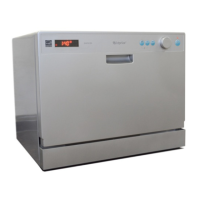11
Cutlery Basket
Silverware should be placed in the cutlery basket with handles directed
oward the bottom. If the rack has side baskets, spoon
s should be loaded
ropriate slots. Knives and other sharp utensils
be
.
sket. This
y place all
• Be sure the similar pieces of silverware do not nest together.
re with handles-down.
er
The amount of detergent to use depends on whether your water is hard or
soft. With hard water, you need extra detergent to alleviate the deposits
that are left by the excessive minerals. Less detergent is needed for soft
water.
To identify whether your water is hard or soft, contact your water
department. A water softener is recommended for water that contains
twelve or more grains. Without it, lime can build up in the water valve,
which could stick while open and cause flooding. Too much detergent
with soft water can cause a permanent cloudiness of glassware, called
etching.
or heavily soiled loads, use the HEAVY WASH Cycle, fill one or both of
the interior cups, depending on the hardness of your water, and also fill
etergent to place in the dispenser:
Number of Grains Detergent Cups to Fill
t
individually into the app
should be placed in the basket with handles up. Longer utensils should
placed in the horizontal position on the cup shelf instead of in the basket
WARNING: Do not let any item extend through bottom of cutlery ba
may prevent the spray arm from spinning.
For personal safety and a highest quality wash, securel
silverware in the basket:
• Place most silverwa
• Place knives and other potentially dangerous utensils handles-up.
Only Use Proper Detergent
Use only detergent specifically made for use in dishwashers. Keep your
detergent fresh and dry. Do not put powder detergent into the dispens
until you are ready to wash dishes.
F
the open cup on the dispenser lid.
Use the information in the table below as a guideline to determine the
amount of automatic dishwasher d
Less than 4 15 cup
4 to 8 25 cup
8 to 12 15 and 25 cups
Greater than 12 15, 25 cups and the open cup

